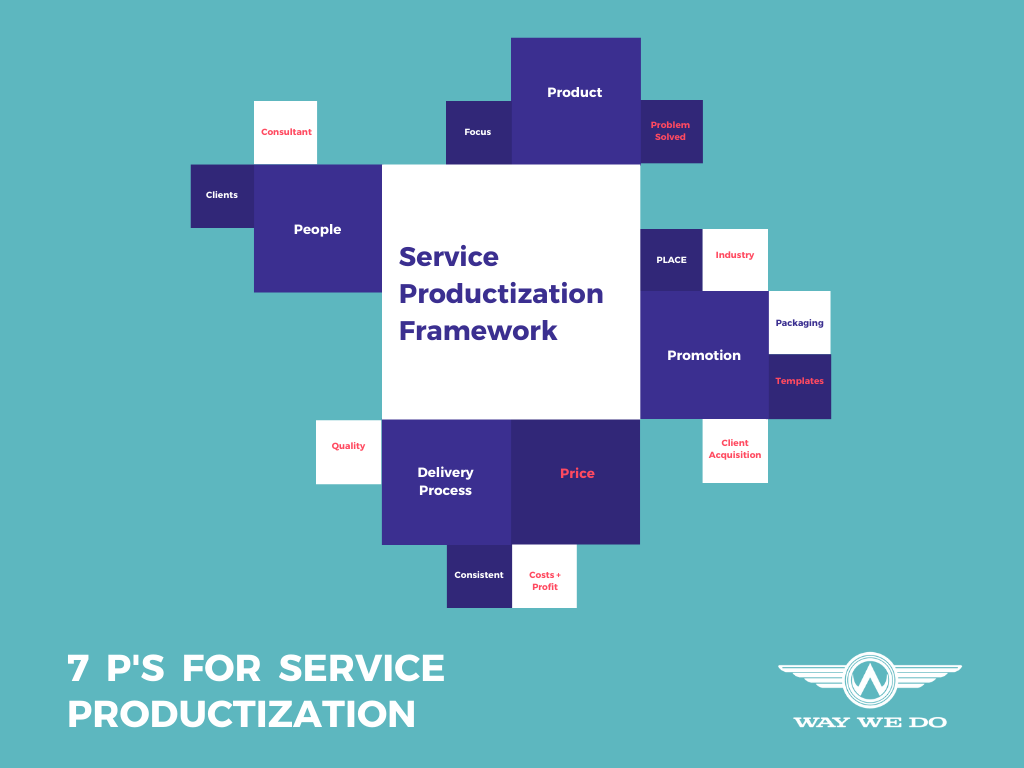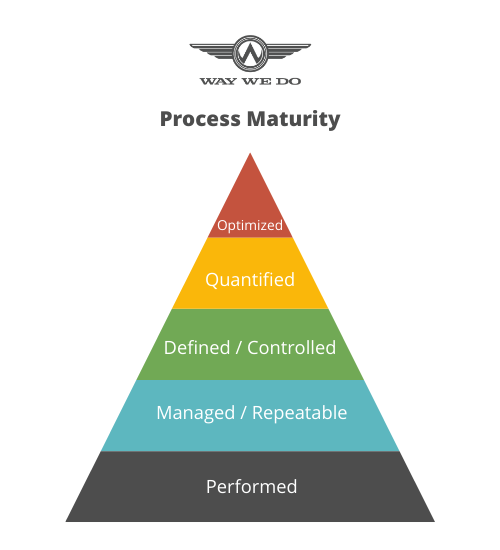As a B2B consulting business, it is an amazing experience to work on big global problems and create bleeding edge solutions. Despite there being a need for consultants like this, these types of projects entail a lot of research and development (R&D), and unless you are being paid for every hour you dedicate to this endeavor, it is a very costly business to be in.
Unfortunately, there are some consulting firms that use the same approach for solving problems where proven practice solutions, methodologies and processes already exist. Even when the consultant has the expertise in solving a particular problem for their client and they have methodologies in mind, it is implemented in a different way each time. What could have been a profitable engagement, ends up taking additional time, budget, and prevents the consultancy from growing.
Way We Do believes that B2B consulting businesses can scale through 3 simple principles:
- Service productization
- Standardization and automation
- Client institutionalization rates
Principle 1: Service Productization & Model
No matter what size your consulting business is, you will endeavor to productize some or all your consulting services in order to grow and scale. Service productization helps you to lift the limitation of selling limited time for money, and in turn increases profitability. It also helps to sell a consulting service in a more efficient way because it is less ambiguous to the client and makes revenue generation more predictable.
Additionally, with a productized service, you can ensure consistent quality, and deliver the service with less effort due to reusing knowledge, processes and skills each time.

Using a 7 P’s marketing approach, B2B consulting businesses can start to consider how to productize their service offering.
- Product: the service focuses on one specific problem you can solve. Is your knowledge delivered as an in-person or online group session for one or multiple clients? Do you incorporate training first, with activities for the client to implement? Do you provide tools and templates to help them implement rapidly, with ease?
- People: you define who your productized service helps solve a problem. Your consultants are also people you can identify to train and deliver the productized service to free up your time to focus on business growth.
- Place: once you know “who” you are targeting, you need to know “where” they are located, as well as the vertical and/or horizontal industry they are in.
- Price: you charge the same price every time and understand your cost structures and profit targets. Will you charge a one-time fee? Or do clients pay an ongoing monthly fee until they have exhausted enough value?
- Packaging: identifying the documents, templates, presentation materials that will help deliver an exceptional branded client experience
- Promotion: how you will acquire and activate new clients in a cost effective manner
- Process: how the service is delivered consistently at the same quality, time frame and cost
Principle 2: Standardization & Automation
With productization, comes standardization. This does not mean that clients will have a cookie cutter experience, but rather they will feel the B2B consultant they are working with is the expert and is in control of the consulting process. There is nothing worse then paying for a service, whereby you think the person running it has no idea!
 Standardizing the full customer journey from client acquisition to client onboarding and product delivery, to client re-engagement processes will create efficiencies for a consulting firm. More than that, it provides an opportunity to map out processes and add “customer wow” touchpoints to create an amazing client experience — the experience that makes people rave about your service to others in order to generate referrals.
Standardizing the full customer journey from client acquisition to client onboarding and product delivery, to client re-engagement processes will create efficiencies for a consulting firm. More than that, it provides an opportunity to map out processes and add “customer wow” touchpoints to create an amazing client experience — the experience that makes people rave about your service to others in order to generate referrals.
At Way We Do, we endorse “business process management” and “digital process automation”, proven methodologies, to standardize processes. Not only will your consultants understand the steps of a process, it also helps to identify “who” will be completing tasks and activities. Will it be your consultants who will do the activity, or is it outsourced to another provider or even to the client to reduce costs, increase efficiencies, and expedite the delivery process?
Standardization helps you to understand how much a process will cost, and the capacity your consulting team has, to deliver such services.
Standardization does not mean you are unable to be flexible or customize a service to the specific needs of a client. You are able to build “flexibility and customization” into the process to meet your clients’ requirements. In fact, many highly customized products and services are ~70% standardized, with clients having options to tailor it to their particular needs. Even customization can be standardized through predefined options.
Following are example processes that can be standardized in a B2B consulting business to create efficiencies and a consistent experience for clients.
- Lead generation process
- Sales process
- Billing and administration processes
- Onboarding new client process
- Service delivery processes – one for each service
- Client feedback and service rating process
- Testimonial creation process
- Referral management process
- Client engagement renewal process
- Consultant and coach training processes
Artifacts are the documents and materials that are used throughout the client journey with your consulting team. Branded presentations, email signatures, client assessments, and meeting notes are all things that can be standardized to raise your firm’s professionalism and ensuring that your consultants are delivering consistently.
In addition to standardizing processes, there is a natural progression towards Digital Process Automation. Automating steps of processes, or the full process, can eliminate the waste that is associated with manual tasks that can be completed more efficiently by a machine or bot. Automation also ensures that nothing falls through the cracks. However, it is important to monitor the bots on a scheduled basis to ensure they continue to perform, and that no new process has an unintended knock-on effect of causing it to stop.
Principle 3: Increase Your Client Institutionalization Rate
When assisting clients to make improvements in their businesses, it is important that not only to provide strategies to achieve their objectives, but also to help them institutionalize them. Without institutionalization, the strategies are just nice ideas that get people excited and entertained for a while. To be truly effective as a B2B consultant, helping clients to adopt new processes and ensuring they are ingrained will provide long term benefits to their organization. Only then can client organizations make an impact in the community in which they serve.
By increasing your client institutionalization rate, you are seen as a consultant who gets things done. This in turn increases your consultancy’s brand reputation as a “mover and shaker”, rather than a “talker and taker”.
By transforming your client’s business that has measurable results, helps you to generate referrals and testimonials, that grows your consultancy further. To ensure that your consultancy’s recommended strategies, coaching and teaching are institutionalized, they need to be:
- Related to one or several business goals;
- Executed and managed consistently;
- Survive staff or leadership changes;
- Supported by committed resources and infrastructure;
- Retained even during times of stress; and
- Measurable, so collected data can be used to support future process improvements.
Institutionalization can be measured through process maturity levels. Process Maturity is defined by the level in which the process is ingrained in the way work is performed, and there is consistency and commitment to performing the process.
The following 5 process types form the Process Maturity Pyramid and provide a level indicator of how ingrained or institutionalized a process is. As a B2B consulting business recommending improvement strategies, what is your clients’ institutionalization level?

- Performed Processes
A performed process is one whereby the work is completed in an adhoc manner. There is no overall management of the process. - Managed Processes / Repeatable Processes
A managed process is one that is planned and performed according to company policy. It ensures that there are adequate resources to create repeatable outcomes. It typically includes one or multiple stakeholders. The process is monitored, controlled and reviewed on a periodic basis. Management also assess the process to understand to what degree it is adhered to and retained, particularly during times of stress. If the performed process has deviated from the managed process plan or procedure, corrective actions are implemented to ensure the process meets it’s intended objectives. - Defined Processes / Controlled Processes
A defined process is a managed process that is defined and documented in far more detail. It becomes a defined asset of the organization to meet business objectives, and represents investment made that is expected to provide business value — both current and future. A defined process is performed more precisely than a managed process, and focuses upon quality outcomes. - Quantitatively Managed
Quantitatively managed processes are controlled using statistical and quantitative methods to measure product quality, service quality, and other process performance factors. Business objectives, customer and end user needs, and stakeholders performing the process are also considered and measured. Quantitative managed processes is based upon a set of processes, including sub-processes, that produce a product or delivers a service. Quantitative management provides better predictability than a defined process, as it focuses upon quantitative measures, as well as quality. - Optimized Processes
An optimized process is a quantitatively managed process that changes and adapts to current and future business requirements. An incremental continuous improvement program underpins optimized processes, as well as adopting technology innovations.
It’s now your turn to scale your B2B consulting business
Through productization, standardization and automation, and client institutionalization and adoption, your B2B consulting business will naturally scale. These 3 principles create a flywheel that not only helps you to attract and convert clients, but also help you to deliver your consulting service, and get traction within your clients’ businesses.
Start with one specific problem you can solve, test and measure, and build from there. Now, it is over to you.





